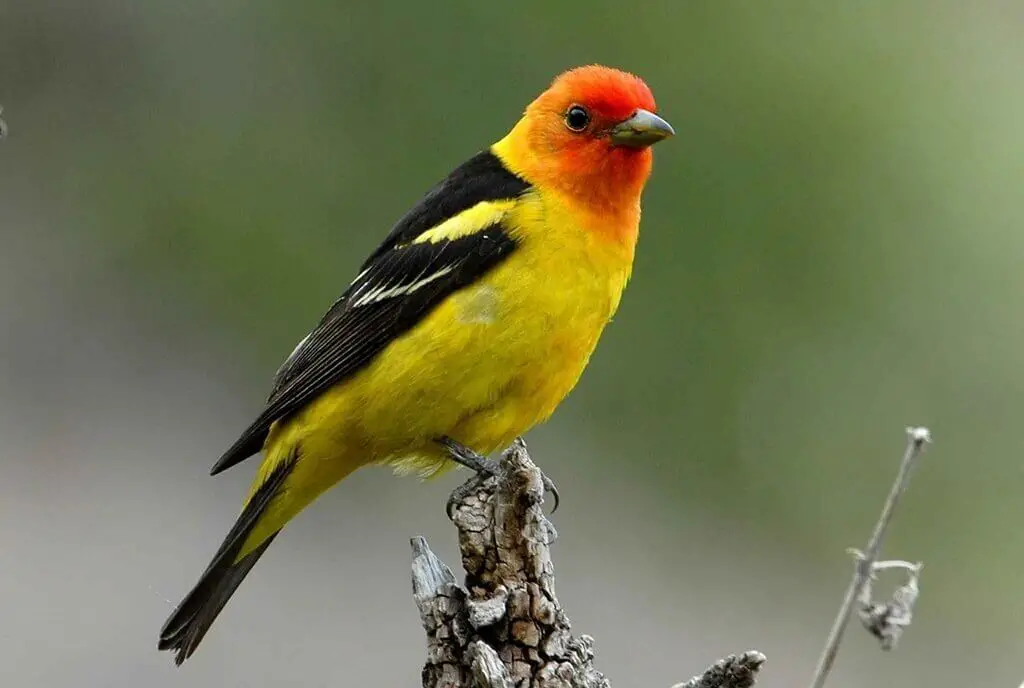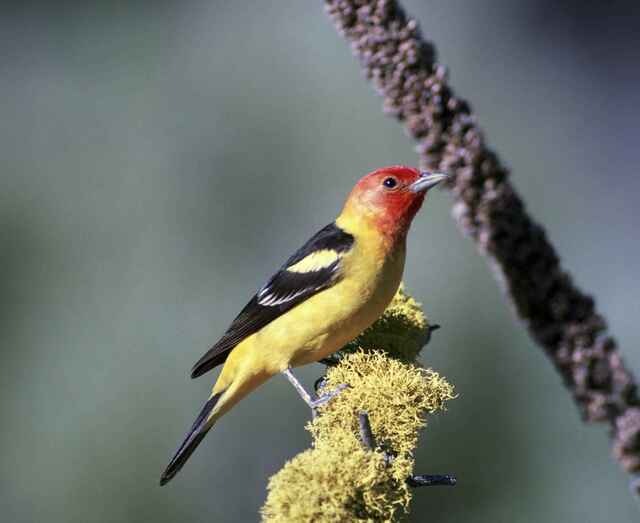
Are you a bird enthusiast looking to add some color to your backyard birding experience? Look no further than the Western Tanager! With its vibrant yellow and red plumage, this species is sure to add some excitement to your yard.
In this birdwatching guide, we will provide comprehensive tips and techniques on how to attract Western Tanager to your yard. Whether you’re a seasoned birder or just starting out, we’ve got you covered.
From creating a bird-friendly habitat to providing food sources, we’ll share everything you need to know to bring these beautiful birds to your yard.
Table of Contents
- 1 Key Takeaways
- 2 How to Attract Western Tanager to your Yard?
- 3 Understanding the Western Tanager
- 4 Creating a Bird-Friendly Habitat
- 5 Providing Food and Water Sources
- 6 Placement of Birdhouses and Nesting Areas
- 7 Creating a Safe Environment
- 8 Attracting Western Tanagers through Sound
- 9 Maintaining and Monitoring Your Yard
- 10 Other Bird Species You May Attract
- 11 Tips for Successful Birdwatching
- 12 Conclusion
- 13 FAQs: How to Attract Western Tanager to your Yard?
- 13.1 How can I attract Western Tanagers to my yard?
- 13.2 What kind of plants should I choose to attract Western Tanagers?
- 13.3 What types of bird feeders should I use to attract Western Tanagers?
- 13.4 How can I reduce window collisions to create a safe environment for Western Tanagers?
- 13.5 Where can I find recordings of Western Tanager calls?
- 13.6 How often should I clean my bird feeders and birdhouses?
- 13.7 What are some other bird species that may be attracted to my bird-friendly yard?
- 13.8 What equipment do I need for successful birdwatching?
- 13.9 How can I observe birds without disturbing them?
- 14 Author
Key Takeaways
- Western Tanagers have unique dietary preferences, favoring insects and specific fruits.
- Offering suet, nectar, mealworms, raisins, and fruits like oranges and berries can entice them to your yard.
- Providing a suet feeder with suet cakes or an orange fruit feeder can yield effective results.
- Their natural diet includes grasshoppers, beetles, ants, bees, caterpillars, wasps, cicadas, and certain berries.
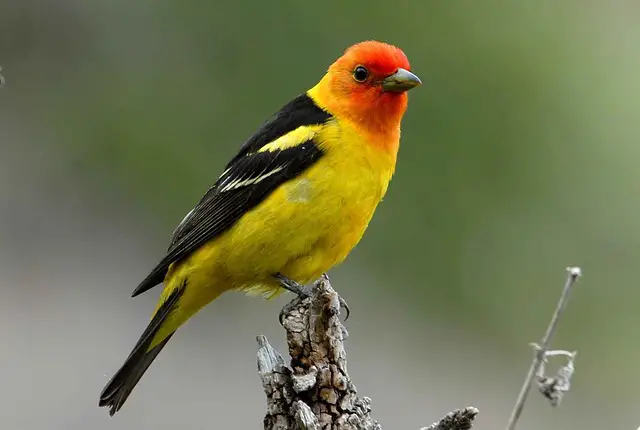
| Aspects | Characteristics |
|---|---|
| Coloration | Bright red head, yellow body, and black wings and tail in males; olive-yellow head, olive-green body, and dusky wings and tail in females |
| Range | Western North America, from Alaska to Mexico |
| Habitat | Coniferous forests and mixed species woodlands |
| Diet | Omnivorous, eats insects, fruits, and seeds |
| Length | 16-18 cm (6-7 in) |
| Weight | 23-28 g (0.8-1 oz) |
| Wingspan | 25-28 cm (10-11 in) |
How to Attract Western Tanager to your Yard?
Entice Western Tanagers with suet, nectar, mealworms, raisins, oranges, and berries. Use an orange fruit feeder. They also relish insects like grasshoppers, beetles, ants, bees, caterpillars, and cicadas.
Understanding the Western Tanager
The Western Tanager is a colorful songbird commonly found in western North America. It is known for its bright yellow body, contrasting black wings, and distinctive red head.
These birds prefer to inhabit coniferous and mixed forests, but can also be found in wooded backyards and parks. They migrate south for the winter, typically to Mexico and Central America.
The Western Tanager is a member of the Cardinalidae family, which includes other colorful birds such as Northern Cardinals and Painted Buntings. It is considered a migratory bird and is protected under the Migratory Bird Treaty Act.
Western Tanager Habitat
Western Tanagers prefer to inhabit coniferous and mixed forests, particularly those with dense understories. They can also be found in wooded backyards and parks, as long as suitable habitat is available.
During the breeding season, Western Tanagers prefer to nest in mature coniferous trees, particularly Douglas Fir and Ponderosa Pine. They typically locate their nests in the outer branches of trees, anywhere from 10 to 60 feet off the ground.
Bird Species in North America
The Western Tanager is one of many bird species found in North America. According to the Audubon Society, there are over 800 bird species that can be found in North America, each with its unique habitat preferences and behaviors.
Some other colorful bird species in North America include the Painted Bunting, Scarlet Tanager, and Indigo Bunting. While observing and attracting these birds can provide a great deal of enjoyment, it is important to remember to respect their natural habitats and behaviors.
Creating a Bird-Friendly Habitat
Attracting birds to your yard requires creating a habitat that is inviting and welcoming. Choosing the right plants and providing nesting areas are two important steps in creating a bird-friendly environment.
Choosing Bird-Attracting Plants
When selecting plants for your yard, consider those that are known to attract birds. Native plants are often the best choice, as they provide the right food and shelter for local bird populations. Some examples of bird-attracting plants include:
| Plant | Attraction |
|---|---|
| Serviceberry | Berries |
| Coneflower | Seed heads |
| Milkweed | Nectar and foliage for caterpillars |
Be sure to choose a variety of plants that bloom and fruit at different times of the year to ensure a consistent food source for birds.
Providing Nesting Areas
In addition to food, birds need safe places to build their nests. Providing birdhouses and natural nesting areas can help attract birds to your yard. When selecting birdhouses, choose those that are specific to the bird species you are trying to attract. For example, a Western Tanager requires a house with a 1.5-inch entrance hole and a 8×8-inch floor. Nesting materials such as twigs, grasses, and small sticks can also be provided.
By creating a bird-friendly habitat with the right plants and nesting areas, you can attract a variety of bird species to your yard, including the Western Tanager.
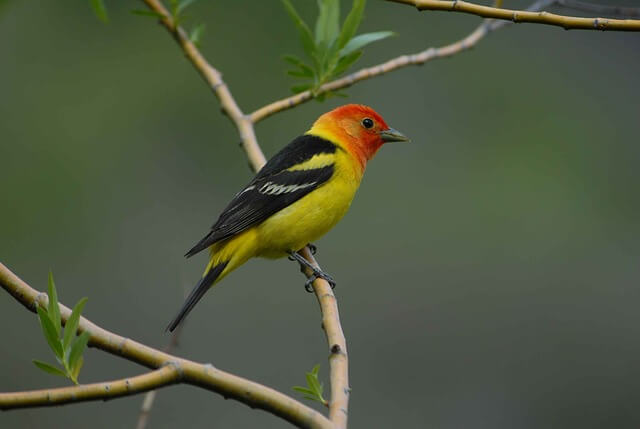
Providing Food and Water Sources
Providing a variety of food and water sources is an effective way to attract a wide range of bird species to your yard, including Western Tanagers. While Western Tanagers are not known to eat birdseed, they are attracted to fruit feeders and nectar feeders.
Setting up a fruit feeder or a platform feeder with offerings such as oranges, grape jelly, or sliced apples is a great way to attract Western Tanagers to your yard. You can also try offering other fruits such as berries, cherries, and plums, as well as other types of food such as mealworms and suet in winter.
It’s important to keep in mind that different bird species have different dietary needs, so offering a variety of food options can help attract a wider range of birds to your yard.
In addition to food sources, providing a source of fresh water is also important for attracting birds to your yard.
Birds need water for drinking and bathing, and providing a bird bath or fountain can be a great way to attract birds to your yard.
Make sure to keep the water source clean and fresh, and change the water regularly to prevent the spread of disease.
Overall, providing a variety of food and water sources is a great way to attract birds to your yard, including Western Tanagers.
By offering a range of food options and a fresh water source, you can create an inviting environment that will attract a wide variety of bird species throughout the year.
Placement of Birdhouses and Nesting Areas
Providing nesting areas for Western Tanagers is an essential part of creating a bird-friendly habitat. Birdhouses are a great way to attract Western Tanagers and other bird species. However, proper placement is critical to their success.
The most important factor in birdhouse placement is height. Birdhouses should be placed at least six feet off the ground, but no higher than 15-20 feet. This height range will provide protection from predators while still being easily accessible for the birds.
Location is also important. Birdhouses should be placed in an area that is free from disturbances, such as traffic or other pets. Additionally, the entrance hole should face away from prevailing winds to keep the nesting box from getting too cold.
The safety of the birdhouse is also crucial. Birdhouses should be securely attached to a pole or tree and away from any potential hazards, such as tree branches or power lines. Make sure to check the stability of the birdhouse regularly and make any necessary repairs.
Finally, keep in mind the habitat preferences of the Western Tanager. Placing birdhouses among the right trees and shrubs will help attract this beautiful bird species to your yard.
Creating a Safe Environment
To attract birds to your yard, it’s essential to create a safe environment that minimizes potential hazards. Here are some tips:
Reduce Window Collisions
Window collisions are a significant cause of bird mortality. To reduce the risk of collisions:
- Install window decals and UV-reflective treatments to make windows more visible to birds
- Move bird feeders and bird baths away from windows
- Close curtains or blinds when not in use
Minimize Pesticide Use
Chemical pesticides can be harmful to birds and other wildlife. Whenever possible, use natural methods to control pests:
- Plant species that naturally repel pests
- Use insecticidal soap or neem oil instead of chemical pesticides
- Encourage natural predators of pests, such as birds and beneficial insects like ladybugs
Manage Predators
Predators like cats and squirrels can pose a threat to birds and their nests. To manage predators:
- Keep cats indoors or use a cat enclosure
- Install squirrel-proof bird feeders
- Prune trees to eliminate branches that provide easy access to birdhouses or nests
By taking these steps, you can create a safe environment that attracts Western Tanagers and other bird species to your yard.
Attracting Western Tanagers through Sound
Another effective way to attract Western Tanagers to your yard is through the use of sound. The unique calls of these birds can be heard throughout their range in the western United States and Canada. By playing these sounds in your yard, you can create an inviting atmosphere that will attract Western Tanagers and other bird species.
Using Bird Calls
There are several ways to incorporate bird calls into your yard. One option is to use a bird call app or CD, which can provide a variety of bird calls to play in your yard. You can also purchase bird call devices that play recordings of specific bird species.
When using bird calls, it is important to use them sparingly and at appropriate times. Avoid using them during migration season or when it may disturb nesting birds. It is also important to keep in mind that excessive use of bird calls can attract predators and may disturb the natural behavior of birds in your yard.
Creating a Natural Soundscape
In addition to using bird calls, you can create a natural soundscape in your yard that will attract Western Tanagers. Planting bird-friendly shrubs and trees can provide a habitat for birds and create a diverse soundscape of various bird calls and natural sounds.
You can also add a birdbath or small fountain to your yard, which will provide a source of fresh water and create a soothing sound that will attract birds to your yard.
By incorporating sound into your bird-friendly yard, you can enhance the natural beauty of your surroundings and create an environment that is welcoming to Western Tanagers and other bird species.
Maintaining and Monitoring Your Yard
Attracting Western Tanagers to your yard requires ongoing maintenance and monitoring. Here are some tips to ensure that your yard remains a bird-friendly environment:
- Regular cleaning: Keep your bird feeders and bird baths clean to prevent the spread of disease. Use a solution of 1 part bleach to 9 parts water to disinfect your feeders and baths.
- Observation: Take the time to observe the birds in your yard. This can help you identify any problems and make adjustments as needed.
- Make adjustments: If you notice that certain bird species are not visiting your yard, try changing the types of food you offer or adding more nesting areas.
Monitoring your yard can also help you identify any safety issues. Here are some steps you can take to ensure a safe environment for birds:
- Reduce window collisions: Birds can easily collide with windows, so consider installing bird-safe window treatments or placing decals on the glass.
- Minimize pesticide use: Pesticides can harm birds and other wildlife, so try to use organic methods for controlling pests.
- Manage predators: Keep an eye out for any predators that may be targeting the birds in your yard. You can deter them by adding birdhouses that have predator guards or by using motion-activated sprinklers.
By maintaining and monitoring your yard, you can create a welcoming environment for Western Tanagers and other bird species.
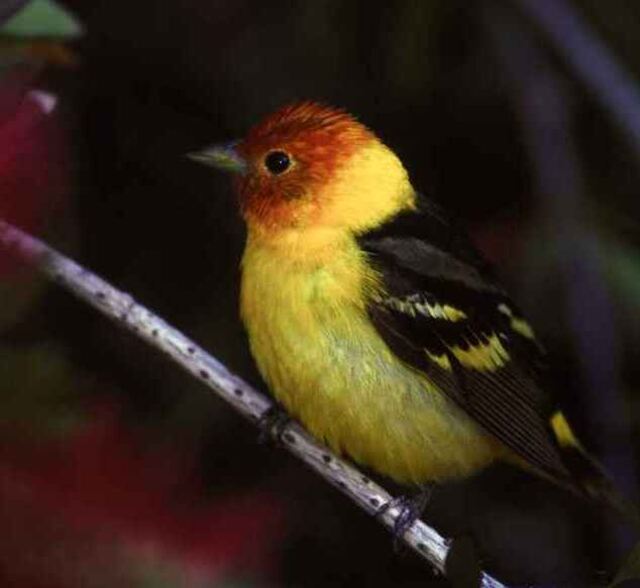
Other Bird Species You May Attract
Attracting Western Tanagers to your yard is a great way to enjoy their beautiful colors and unique song. However, creating a bird-friendly habitat can also attract other bird species to your yard, providing even more opportunities for birdwatching. Here are some other bird species you may attract:
| Bird Species | Habitat Preferences |
|---|---|
| American Goldfinch | Open fields, gardens, and meadows with thistle plants |
| Black-capped Chickadee | Forests, woodlands, and suburban areas with deciduous trees |
| House Finch | Suburban areas with bird feeders and water sources |
| Ruby-throated Hummingbird | Gardens, meadows, and woodlands with nectar-producing plants |
| Spotted Towhee | Brushy areas, woodlands, and suburban gardens |
These bird species are all common in North America and have unique characteristics that make them a joy to watch. By creating a bird-friendly habitat and providing the appropriate food, water, and shelter, you can attract a diverse range of bird species to your yard.
Tips for Successful Birdwatching
Birdwatching is a delightful and educational hobby that can be enjoyed right in your own backyard. Here are some tips to help you get the most out of your birdwatching experience:
- Invest in good quality binoculars: A good pair of binoculars is essential for birdwatching. Look for binoculars with a magnification of at least 7x and a wide field of view.
- Observe from a comfortable location: Make sure you are comfortable when birdwatching, whether sitting in a chair or standing. Being comfortable will help you stay focused on your observations.
- Be patient: Birdwatching requires patience and perseverance. Birds can be elusive and may take some time to appear. Wait quietly and observe your surroundings.
- Use field guides: Field guides are an excellent resource for identifying birds and learning about their habits and habitat. Keep a field guide nearby and refer to it often.
- Record your observations: Keep a record of the birds you observe and when you saw them. This will help you track the migration patterns of different bird species and anticipate their return to your yard.
- Respect the birds and their habitat: Avoid disturbing the birds and their habitat. Keep a respectful distance and observe quietly from a distance. Do not touch or move anything in the bird’s environment.
- Share your knowledge: Share your love of birdwatching with others. Take the time to teach your friends and family about the birds you observe and the importance of preserving their natural habitat.
By following these tips, you will be well on your way to becoming a successful birdwatcher and attracting a variety of bird species to your yard.
Conclusion
Attracting Western Tanagers to your yard can provide endless enjoyment for birdwatchers and is an achievable goal with the right techniques. By creating a bird-friendly habitat, providing food and water sources, and offering nesting areas, you can make your yard a welcoming environment for these striking birds.
It is important to maintain and monitor your yard regularly to ensure that it remains a safe and attractive space for Western Tanagers and other bird species. Incorporating bird calls and sound is another effective way to increase bird activity in your yard.
Attracting Western Tanagers to your yard will also likely attract other bird species, providing additional opportunities for birdwatching. With the right equipment, observation techniques, and etiquette, you can make the most out of your birdwatching experience.
Overall, incorporating the tips and techniques discussed in this guide can transform your yard into a haven for Western Tanagers and other bird species. Happy backyard birding!
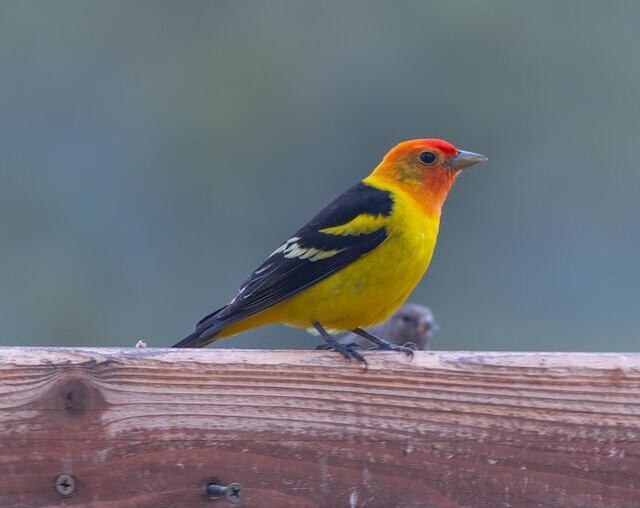
FAQs: How to Attract Western Tanager to your Yard?
How can I attract Western Tanagers to my yard?
To attract Western Tanagers to your yard, you can create a bird-friendly habitat by choosing the right plants and providing nesting areas. Additionally, providing food and water sources, placing birdhouses and nesting areas strategically, creating a safe environment, using sound to attract them, and maintaining and monitoring your yard are all effective methods.
What kind of plants should I choose to attract Western Tanagers?
Western Tanagers are attracted to a variety of plants, including berry-producing shrubs and trees such as serviceberries, chokecherries, and elderberries. They also enjoy nectar-producing flowers like fuchsia, penstemon, and honeysuckle. Planting a mix of these types of plants will increase your chances of attracting Western Tanagers.
What types of bird feeders should I use to attract Western Tanagers?
Western Tanagers are primarily insectivorous birds, so offering suet feeders with high-quality insect suet can be a great option. They also eat berries and fruit, so platform feeders with fresh berries or sliced fruits can be enticing. It’s important to ensure that the feeders are placed in a safe and accessible location for the birds.
How can I reduce window collisions to create a safe environment for Western Tanagers?
To reduce window collisions, you can apply window decals or tape that makes the glass more visible to birds. Placing feeders and birdhouses within three feet of windows can also help birds recognize that the glass is a barrier. Additionally, closing blinds or curtains partially can minimize reflections that may confuse birds.
Where can I find recordings of Western Tanager calls?
Recordings of Western Tanager calls can be found on various birding websites or mobile apps dedicated to bird identification and sounds. These platforms often have extensive libraries of bird calls that you can listen to and even download to play in your yard to attract Western Tanagers.
How often should I clean my bird feeders and birdhouses?
It is recommended to clean your bird feeders and birdhouses at least once every two weeks. Use a mild detergent and water to scrub away any dirt or mold, and rinse thoroughly before refilling or rehanging. Regular cleaning helps prevent the spread of diseases and ensures a healthy environment for the birds.
What are some other bird species that may be attracted to my bird-friendly yard?
Apart from Western Tanagers, you may attract other beautiful bird species such as American Goldfinches, Black-capped Chickadees, House Finches, Northern Flickers, and Ruby-throated Hummingbirds. These bird species also appreciate a bird-friendly habitat and the availability of food, water, and nesting areas.
What equipment do I need for successful birdwatching?
Some essential equipment for birdwatching includes binoculars, a bird identification field guide or mobile app, a notebook or birding journal, and a comfortable pair of walking shoes. It can also be helpful to have a spotting scope for long-distance viewing and a camera to capture memorable moments.
How can I observe birds without disturbing them?
To observe birds without disturbing them, it’s important to maintain a respectful distance and avoid sudden movements or loud noises. Use binoculars or a spotting scope to get a close-up view without intruding on their space. Stay quiet and minimize any potential disruptions to allow the birds to behave naturally.

